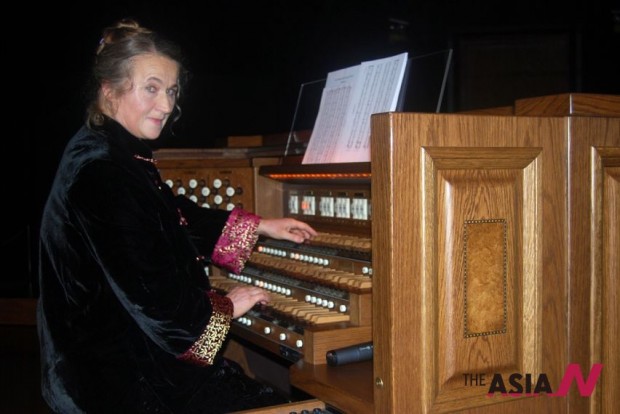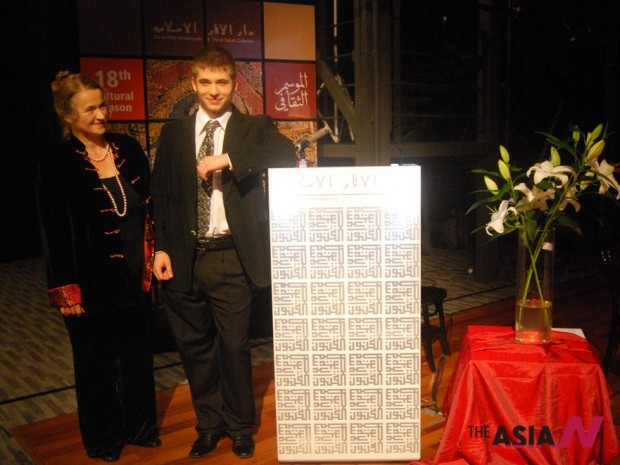Polish organist enchants Arabic audience with the only organ in Arabian peninsula
Tonight, as we leave Al-Maidan Cultural Centre, of Dar Al-Athar Al-Islamyya, after attending one of its 18th Cultural Season musical events, we felt we are touching the sky of creation.
The Polish musician maestro Valentina M.Baginska, and her son Karol Kusmider helped the audience to get acquainted with the only organ in the Arabian peninsula. Mr. Karol, lectured us on the history and development of the organ that is considered to be one of the oldest instruments still used in European classical music.
Its earliest predecessors Hydraulis were built in Ancient Greece in the 3rd century BC. The word organ derived from the Latin organum, an instrument similar to a portative organ used in ancient Roman circus games. Organum derived in turn from the Greek organon.
The water organ or hydraulic is a type of pipe organ blown by air, where the power source pushing the air is derived by water from a natural source (e.g. by a waterfall) or by a manual pump. Consequently, the water organ lacks a bellows, blower, or compressor. It is attributed to the Hellenistic scientist Ctesibius (Ktesibius) of Alexandria, an engineer of the 3rd century BC. The hydraulic was the world’s first keyboard instrument and was, in fact, the predecessor of the modern pipe organ.
Typically, water is supplied from some height above the instrument through a pipe, and air is introduced into the water stream by aspiration into the main pipe from a side-pipe holding its top above the water source. Both water and air arrive together in the camera wind chamber. Here, water and air separate and the compressed air is driven into a wind-trunk on top of the camera wind chamber, to blow the organ pipes. Two perforated ‘splash plates’ or ‘diaphragms’ prevent water spray from getting into the organ pipes.
The water, having been separated from the air, leaves the camera wind chamber at the same rate as it enters. It then drives a water wheel, which in turn drives the musical cylinder and the movements attached. To start the organ, the tap above the entry pipe is turned on and, given a continuous flow of water, the organ plays until the tap is closed again.
Large organs such as the one installed in 1361 in Halberstadt, Germany, was the first documented permanent organ installation. The Halberstadt organ was the first instrument to use a chromatic key layout across its three manuals and pedal board, although the keys were wider than on modern instruments. It had twenty bellows operated by ten men, and the wind pressure was so high that the player had to use the full power of his arm to hold down a key.
By the 7th century AD, bellows were used to supply organs with wind. Beginning in the 12th century, the organ began to evolve into a complex instrument capable of producing different timbres.
Until the mid-15th century, organs had no stop controls. Each manual controlled ranks at multiple pitches, known as the Blockwerk. Around 1450, controls were designed that allowed the ranks of the Blockwerk to be played individually.
By the 17th century, most of the sounds available on the modern classical organ had been developed. From that time, the pipe organ was the most complex man-made device until the late 19th century.
During the Renaissance and Baroque periods, the organ’s tonal colors became more varied. Organ builders fashioned stops that imitated various instruments. The Baroque period is often thought of as organ building’s “golden age,” as virtually every important refinement was brought to a culminating art.
Maestro Valentina M.Baginska, being a professor in the Music Institute of Kuwait, was clever enough to show demonstration of different ways of playing organs.
The night was concluded with an ORGAN RECITAL, when maestro Valentina M.Baginska played for almost 40 minutes some of the most famous and nice pieces written for this classical instrument.
We listened to the works of Diomedes Cato who was an Italian-born composer and lute player, lived and worked entirely in Poland. He mixed the style of the late Renaissance with the emerging Baroque, and also Italian idioms with Polish folk material.
Also there was Janos Bakfark , the Hungarian and Polish composer of Saxon origin, and lutenist of the Renaissance. He was enormously influential as a lutenist in his time, and renowned as a virtuoso on the instrument.
The gagliarda was a form of Renaissance dance and music popular all over Europe in the 16th century. It is mentioned in dance manuals from England, France, Spain, Germany and Italy, among others.
Besides. Audience who came with short notice, regarding the non stable state of such event in Kuwait because of some social unstability, listend to a work by Tomás Luis de Victoria was the most famous composer of the 16th century in Spain. And Joannis de Lublin who was a Polish composer and organist who lived in the first half of the 16th century. Not much is known about his life. From 1537 to 1548, he created the famous organ tablature. This is the largest organ tablature in the world (more than 350 compositions and theoretical treatise) and one of the earliest.
The master piece was of Johann Sebastian Bach, the a German composer, organist, harpsichordist, violist, and violinist of the Baroque Period. He enriched many established German styles through his skill in counterpoint, harmony, and the adaptation of rhythms, forms, and textures from abroad, particularly from Italy and France. His music is revered for its intellectual depth, technical command, and artistic beauty.





































































